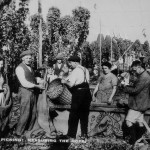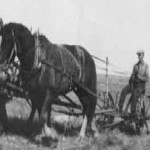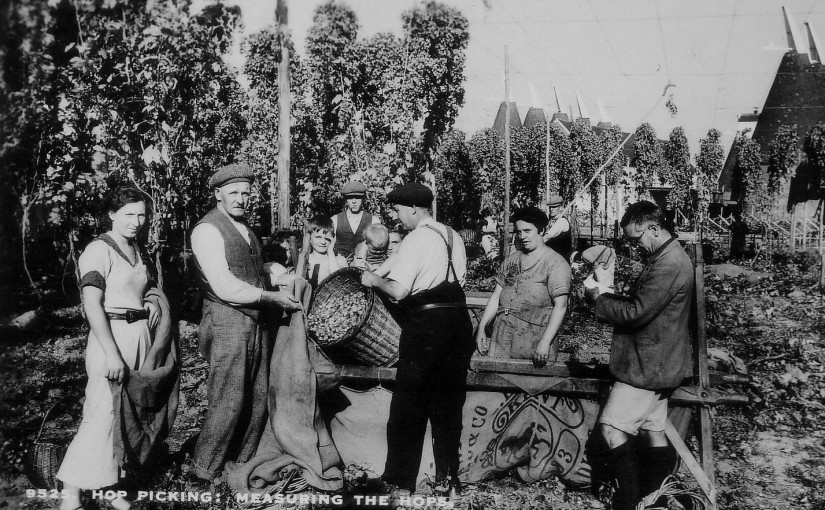By A Leadbetter
When I left school I spent two years learning about the job on two different farms. My father had a small holding which he thought I might take over at some point.
On a twelve mile length of road there were fifteen farms some small but none with any great acreage. Only four had hop gardens, eight had cows for milking, one had pigs, all under one big shed divided up into styes and fed on wet food. You never get good pork from pigs on dry food. This farmer also kept a heard of Jersey cows for cream, so all of the skimmed milk went to the pigs.
In hop gardens, in the earlier times, the hops were grown up poles three poles to a hill and hop bines were trained up the poles and tied with rushes. This work was done by the women. When the hops were ready they were picked. Hop picking took anything up to six weeks. Next, after the crop was in, came the striping of the bines from the poles. By now a lot of ploughing had been done, mostly by horses only one furrow at the time, hoping to get it done before the hard frost set in.
The period I am writing about is from nineteen twenty six and we did have some hard frost. When the ploughed ground was really hard it was time to clean out the bullock yards, the slurry was dug out and put in dung carts and then spread over the ploughed ground. That is where the hop bines came in they made good footing when covered with any old straw.
Now we would be thinking about winter feeds. Some farms had cow cabbage some had worzels others had mangles and swedes these provided a nice wet food. In my early days the wheat sewing was done by hand the men had a leather brace attached to a huge trug filled with wheat. The seed was spread over the ground using both hands.
For seed sowing there was a team that marked out the tiny furrows to drop the seeds in. This was done by a handle on a tin with a small hole for the seeds to be dropped into.
Haying was hard in the time before mowing machines. The grass was cut by three or four men with scythes, after a day or two the women would turn the hay with hay rakes until it was dry and ready for picking up and stacking. It was quite a site to see all the women and men in their straw hats, the men with their Rovendens tied up just below the knee this was to stop the field mice from running up their legs. When the mowing machines started to come onto the farms in this area they cut the grass but it still had to be turned by hand. Next came the corn reapers. Only a few farms had them so once their own crop was in they would help the other farmers. All corn and hay was stacked, corn in round and hay in oblong stacks. All these hay ricks had to be thatched and because there were only three thrashing machines in the area each farm had to take its turn. One thing I can not understand is why is our wheat so short today, when years ago the wheat ears were so long. These ears produced more better flour than we get today. These days everything used on the farms is mechanized.
I also learned the gory side of farming some of which I could not repeat. Our local slaughter houses have gone, every butcher had his own slaughter house, all the bullocks, pigs and sheep were bought locally and produced, in my opinion the best meat we have ever had. The meat we get today with no fat is like a lot of chafe, you will never get good meat with animals fed on hard nuts.
After a good bacon breakfast there was always enough bacon fat left when the pan cooled to spread on bread . The same with the beef dripping, cows and sheep are grass eating animals. Pigs like sloppy food. If any one tells you fat is not good for you do not believe them. I cannot get enough on our meat today, without fat there is little flavour.
First Published in “Cinque Ports” November 2015
All articles, photographs, films and drawings on this web site are World Copyright Protected. No reproduction for publication without prior arrangement. (Hard Copy Back Numbers Still Available) © World Copyright 2017 Cinque Ports Magazines Rye Ltd., Guinea Hall Lodge Sellindge TN25 6EG
